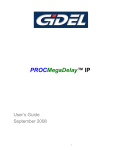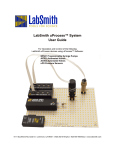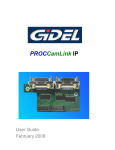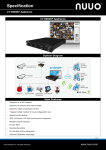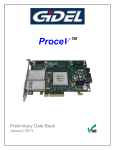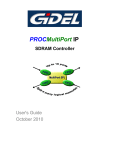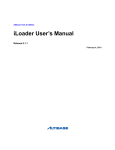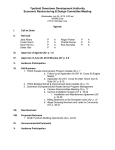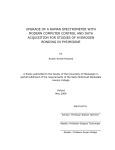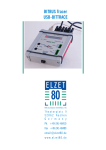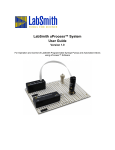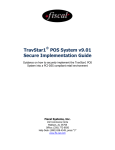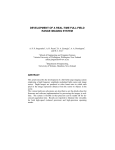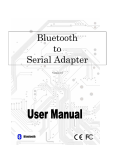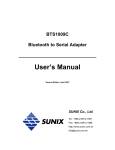Download PROCMegaFIFO User Guide
Transcript
PROCMegaFIFO IP User's Guide September 2008 GiDEL products and their generated products are not designed, intended, authorized, or warranted to be suitable for use in life-support applications, devices or systems or other critical applications © 1993 - 2008 by GiDEL Ltd. All rights reserved. GiDEL, PROCStar II™, PROCSpark II™, PSDB™, PROCWizard™, PROCCamLink™, PROCMultiPort™, PROCMegaFIFO™ and other product names are trademarks of GiDEL Ltd., which may be registered in some jurisdictions. This information is believed to be accurate and reliable, but GiDEL Ltd. assumes no responsibility for any errors that may appear in this document. GiDEL reserves the right to make changes in the product specifications without prior notice. Windows NT, Windows XP, Windows 2000, Stratix II, EP2S60, DDRII, CameraLink and other brands and product names are trademarks or registered trademarks of their respective holders. USA 1600 Wyatt Drive Suite 1 Santa Clara, CA 95054, USA Tel: 1 - 408 - 969 - 0389 Fax: 1 - 866 - 615 - 6810 Worldwide 2 Ha'ilan Street, P.O. Box 281 Or Akiva, Israel 30600 Tel: +972 - 4610 - 2500 Fax: +972 - 4610 - 2501 [email protected] [email protected] Web: www.GiDEL.com [email protected] Contents Introduction .....................................................................................................1 PROCMegaFIFO Key Features .......................................................................2 Setting Up PROCMegaFIFO Using PROCWizard .........................................3 Using PROCMegaFIFO .................................................................................11 General Notes ..........................................................................................11 Working with SimpleFIFO ........................................................................ 11 Resetting and starting SimpleFIFO: ........................................................... 12 Reset from Hardware: ...................................................................................... 12 Reset from Software: ........................................................................................ 12 Accessing SimpleFIFO from hardware: ..................................................... 12 Writing to FIFO: ............................................................................................... 12 Reading from FIFO: ......................................................................................... 12 Accessing SimpleFIFO from software: ....................................................... 13 Working with limited packets (not an infinite stream): ................................ 13 LIMITATIONS ............................................................................................. 14 Working with MultiFIFO ............................................................................14 Resetting and starting MultiFIFO: .............................................................. 14 Accessing MultiFIFO from hardware: ......................................................... 14 Writing to MultiFIFO with multiple write ports (Local-to-PCI) : ............ 14 Reading from MultiFIFO with multiple read ports (PCI-to-Local) : ....... 14 Accessing MultiFIFO from software: .......................................................... 15 PROCMegaFIFO Parameters and Signals...................................................18 Parameters for SimpleFIFO .....................................................................18 Signal/Bus Names for SimpleFIFO .......................................................... 19 Parameters for MultiFIFO ........................................................................20 Signal/Bus Names for MultiFIFO .............................................................20 Figures Figure 1 – Configuration Mode Icon .............................................................................. 3 Figure 2 – Accessing MegaFIFO in IC Component Drop-Down Menu ......................... 4 Figure 4 – The FIFO Selector ........................................................................................ 5 Figure 5 – SimpleFIFO Properties Dialog ...................................................................... 6 Figure 6 –Simple FIFO Configuration Screen ............................................................... 7 Figure 7 – MultiFIFO Properties Dialog ......................................................................... 8 Figure 8 – MegaFIFO Ports List .................................................................................... 9 Figure 9 – MegaFIFO Port Settings ............................................................................... 9 Figure 10 – Set MegaFIFO Ports List .......................................................................... 10 Tables Table 1 – CMultiFIFO Simple Mode Methods ............................................................................ 15 Table 2 – CMultiFIFO Effective Mode Methods ......................................................................... 16 Table 3 – CMultiFIFO General Methods .................................................................................... 17 Table 4 - SimpleFIFO Parameter Names .................................................................................. 18 Table 5 – SimpleFIFO Signal and Bus Names .......................................................................... 19 Table 6 – MultiFIFO Parameter Names ..................................................................................... 20 Table 7 – MultiFIFO Signal and Bus Names ............................................................................. 21 Introduction PROCMegaFIFO™ IP is a GiDEL Intellectual Property that provides a simple and convenient way to transfer data to / from GiDEL PROC boards. With MegaFIFO, data may be transferred between the host PC and user’s subdesigns, or between subdesigns, using the on-board memory, or SODIMM memory module, as a very large FIFO. MegaFIFO eliminates the need to take care of synchronization when transferring data between designs running at different clocks. The software no longer needs to respond to the hardware in real-time and hardware designs may now transfer data in bursts and withdraw it in a continuous stream. MegaFIFO uses special arbitration techniques when transferring data between the host PC and user’s subdesigns. These techniques prevent memory overflows / underflow, thus using the maximum available bandwidth for data transfers. MegaFIFO is simple to use. Its straightforward interface is based on the familiar PROCMultiPort interface. Request and Acknowledge signals ensure correct data transfers. On the software side, the Proc class methods perform automatic initialization of the FIFO logic and enable easy data transfers using DMA. 1 PROCMegaFIFO Key Features GiDEL PROCMegaFIFO™ IP was designed to provide an effective and simple means of using the on-board memory space. MegaFIFO defines the on-board memory (or a part of it) as a FIFO storage or as a synchronization buffer. The main advantage of MegaFIFO is its ability to work with huge memory banks and define large FIFO memories in various configurations. The FIFO memory bank may be on-board DDR memory or memory modules connected to SODIMM sockets. MegaFIFO uses cyclic memory pointers. This way, a virtual infinite memory space is created, assuming that the memory bandwidth is not exceeded. MegaFIFO IP consists of two IPs: SimpleFIFO has two data ports: a source write port and a destination read port. Simple FIFO behaves as a large FIFO buffer between those ports. Each of the ports can be connected to user’s subdesign or to PCI (host software). MultiFIFO makes possible to send or receive large amounts of data from or to the host software. MultiFIFO has a single port connected to the host PC and multiple ports connected to user’s subdesigns. The data is transferred from / to the subdesigns using a single DMA channel to eliminate situations when several DMA channels are competing on the PCI channel. This way, the highest data transfer rate is achieved. MegaFIFO IP key features include: 9 User-friendly design with standard input and output interface 9 Optimized for easy control from hardware and software 9 Large memory buffers managed using cyclic memory pointers 9 High data transfer rates using a single DMA channel for multiple transfers to ensure maximum performance 9 Automatic data transfer rate management to avoid buffer underflow and overflow 2 Setting Up PROCMegaFIFO Using PROCWizard 1. At least one of MegaFIFO ports is always connected to a user’s subdesign. You should have your source / destination subdesigns ready and defined before you start setting up the MegaFIFO. 2. In the current version of PROCDeveloper’s Kit, it is not be possible to put a MegaFIFO in the same memory bank as a MultiPort, and vice versa. Important You should have your target subdesign ready before you start setting up the MegaFIFO. The following should be defined: IC(s) Main clock and memory clock User designs and with appropriate clocks To learn how to define subdesigns, please refer to PROCWizard User's Manual. To set up PROCMegaFIFO using PROCWizard: 1. Click the button in PROCWizard's toolbar, shown in the figure below, to enter the Configuration Mode in GiDEL PROCWizard. Figure 1 – Configuration Mode Icon The Configuration Mode is used to build designs in PROCWizard. New items can be added to the design in this mode and existing items can be redesigned. To learn more about configuration mode, please refer to PROCWizard User's Manual. 3 2. Click the "+" sign to the left of the Designs Card [proc card type] item to expand it. 3. Right click on the name of the desired IC, to access the IC component drop-down menu and select GiDEL IP Core Æ MegaFIFO. Figure 2 – Accessing MegaFIFO in IC Component Drop-Down Menu 4 The FIFO Selector appears: Figure 3 – The FIFO Selector The FIFO Selector provides two FIFO types: SimpleFIFO MultiFIFO (can be Local-to-PCI or PCI-to-Local) A SimpleFIFO may be used to transfer data between a PCI PORT and user’s subdesign or between two subdesigns. This FIFO type always has one write port and one read port and has a very simple interface. A MultiFIFO is used to transfer data between the software and one or several of user’s subdesigns. When users wish to transfer data between the software and several subdesigns, it is always better to use a MultiFIFO and not several SimpleFIFO. This will significantly enhance performance and reduce usage of FPGA cells. 5 To set up SimpleFIFO: 1. Choose SimpleFIFO from the FIFO Selector. The SimpleFIFO properties dialog appears. Figure 4 – SimpleFIFO Properties Dialog 2. In SimpleFIFO define the following properties: The Name of the FIFO memory The Memory Size to be allocated for the FIFO The Memory Bank in which the FIFO will reside. If the selected Memory Bank is a SODIMM memory, then a SODIMM group box with the fields Density and Type will appear in the SimpleFIFO Properties dialog box(See Figure 4). ¾ Click the Density arrow to select one of the possible memory densities. ¾ Click the SODIMM Type arrow to select your SODIMM’s memory type. To determine your SODIMM’s type, refer to the GiDEL SODIMM Type Datasheet document. In accordance to the SODIMM’s Type, the PROCWizard will automatically generate a customized design. 6 3. Click Next to continue the configuration of SimpleFIFO. Figure 5 –Simple FIFO Configuration Screen 4. Define SimpleFIFO by selecting the: Desired Source and Destination Ports. A PCI Port will be connected to the software and a Non-PCI port will be connected to user’s subdesign. A previously created subdesign Entity for a Non-PCI Port For a Non-PCI port, define: a Clock to synchronize the data with, and the Port Width (the data width in bits). The Reset Source. The Reset Source offers two options: ° Host (resetting the FIFO occurs from the software) ° Subdesign (resetting the FIFO occurs from the selected subdesign) Note If a subdesign was selected as a reset source, the user has to ensure that the reset logic exists in that subdesign. 5. Click Finish to accept the Simple FIFO settings. 7 To set up MultiFIFO: Choose MultiFIFO from the FIFO Selector. The MultiFIFO Properties dialog appears. Figure 6 – MultiFIFO Properties Dialog 6. In MultiFIFO mode define the following: The Name of the FIFO memory The Non-PCI Ports Count (Write ports for Local-to-PCI MultiFIFO, or Read ports for PCI-to-Local MultiFIFO) The Memory Size per Port (amount of memory that should be allocated for each port) The Memory Bank in which the FIFO will reside If the selected Memory Bank is a SODIMM memory, then a SODIMM group box with the fields Density and Type will appear in the MultiFIFO Properties dialog box (See Figure 6). Click the Density arrow to select one of the possible memory densities. ¾ Click the SODIMM Type arrow to select your SODIMM’s memory type. To determine your SODIMM’s type, refer to the GiDEL SODIMM Type Datasheet document. In accordance to the SODIMM’s Type, the PROCWizard will automatically generate a customized design. ¾ Note There is a maximum of 16 ports per memory bank - this includes all MegaIP ports. The Total Memory Size that appears on the right is the product of the Non-PCI Ports Count and the Memory Size per Port. This is the total amount of memory that will be allocated for the current MultiFIFO. 8 7. Click Next to continue the configuration of the MultiFIFO in the MegaFIFO Ports List. Figure 7 – MegaFIFO Ports List 8. In the MegaFIFO Ports List, double click on each row to access the Port Settings dialog window. Figure 8 – MegaFIFO Port Settings 9. In Port Settings define: The Name of the Port The subdesign Entity to which the port should be connected The Clock to synchronize the data with The Port Width (data width in bits) 9 10. Click OK return to the MegaFIFO Ports List. Continue setting up all the ports as in the figure below. Figure 9 – Set MegaFIFO Ports List 11. Click Finish to accept the MultiFIFO settings. 10 Using PROCMegaFIFO General Notes SimpleFIFO automatically adjusts the data transfer rate to avoid memory throughput overflow. Therefore, users should be aware of the possibility that data transfer may be reduced due to memory bandwidth overflow. MultiFIFO controls the transfer rate from the PCI side only. User’s logic that works with non-PCI ports of MultiFIFO should take care of the memory bandwidth. To calculate the memory throughput, multiply memory clock rate by memory width and reduce it to 75%. For example: 32bit-bus memory runs on 150MHz: Throughput ≈ 0.75*(32*150*106) = 3.6Gbps If the memory is of DDR type, the final throughput is multiplied by 2: Throughput ≈ 3.6Gbps * 2 = 7.2Gbps The sum of all active ports data rates should be less than the memory throughput. Working with SimpleFIFO SimpleFIFO has two ports: a write (source) port and a read (destination) port. Each port may be a PCI port (connected to the host software) or a non-PCI port (connected to user’s subdesign). The following connection combinations are available: PCI source port and non-PCI destination port : data is transferred from the host software to user’s subdesign Non-PCI source port and PCI destination port : data is transferred from user’s subdesign to the host software Non-PCI source port and non-PCI destination port : data is transferred from one user’s subdesign to another Note that both source and destination ports cannot be PCI ports. 11 Resetting and starting SimpleFIFO: Reset from Hardware: If user’s subdesign was chosen as reset source, a special logic must be added to that subdesign to perform resets. To reset the FIFO the user’s logic has to assert a corresponding reset_fifo_name signal high for at least 3 clocks (the clock domain of the reset signal was chosen during reset source definition in PROCWizard) Reset from Software: If the Host was chosen as reset source, any write to the reset_fifo_name control register from the software will reset the FIFO. Note The clrn signal, which resets the whole board, will reset the FIFO logic, but won’t start it. To start the FIFO, it must be reset either by hardware or by the Host. Accessing SimpleFIFO from hardware: Writing to FIFO: When the data is ready on the source port data bus, assert the write request signal (wr_req_fifo_name) high. The request signal may be set high on the next clock after the reset pulse falls. The source port will acquire data on each clock as long as both write request and write acknowledge signals are high for that port. The fall of the write acknowledge signal of the source port (wr_ack_fifo_name) indicates that the port is not ready to receive data. Possible reasons: bandwidth was exceeded or FIFO memory is full. In the latter case, the data should be read from the read port of the FIFO to free up the memory space. Reading from FIFO: After the data was written to the FIFO it may be read from the read port (destination port). The read acknowledge signal (rd_ack_fifo_name) rises when the data is ready for reading. Assert read request signal (rd_req_fifo_name) high to start reading. The destination port will output data on each clock as long as both read request and read acknowledge signals are high for that port. The fall of the read acknowledge signal of the destination port indicates the port has no more data to output. Possible reasons are: FIFO memory is empty Write port is slower than the read port (FIFO is "starving") Bandwidth has been exceeded 12 Accessing SimpleFIFO from software: If a SimpleFIFO has a PCI port, this port may be accessed by software using DMA. The usage of the SimpleFIFO in that case is similar to that of the MultiPort. Data may be read / written to the PCI ports using standard DMA methods of the Proc class. To learn more about these methods, please refer to the PROCMultiPort Data Book, PROCWizard Data Book and PROC API Data Book. Contrary to MultiPort ports, FIFO ports do not need to be individually reset by software before being accessed. Resetting the FIFO also resets its ports. Important SimpleFIFO automatically manages the data transfer rate via PCI. The DMA transfer will be automatically held when FIFO enters an overflow / underflow state and resumed when FIFO exits that state. However, in case the PCI port is a read port, the user should activate DMA only after the almost_full flag has risen, to ensure that there is enough data for the initial DMA transfer. Working with limited packets (not an infinite stream): The write request signal of the source port should remain high 1 clock after the last word has been written (thus writing one extra word to the FIFO). This action is related to the cases when port width is less than 64 bits wide. Writing an extra word to the FIFO is necessary to make sure the whole packet was transferred to the destination port. When the read port is a PCI port, the writing logic has to assert the flush signal (fifo_name_flush) high after transfer of the last word, thus enabling the PCI logic to read the whole packet. Important After finishing the limited packet transfer, users must reset the FIFO before starting the next packet. 13 LIMITATIONS The minimal single packet size for the SimpleFIFO is 32 words, 64 bits each. Working with MultiFIFO MultiFIFO has a single PCI port connected to the host software and one or more non-PCI ports connected to user’s subdesigns. The data is transferred between the software and the subdesigns using a single DMA channel, thus eliminating competition on the PCI bus. The interface of the non-PCI MultiFIFO ports is similar to that of the non-PCI SimpleFIFO ports. From the software side, the data transfers are managed using methods of the CMultiFifo class (derived from the Proc class). Using these methods, data may be transferred to / from each non-PCI port individually. Resetting and starting MultiFIFO: MultiFIFO is always reset by the software. There is no way for user’s subdesigns to reset MultiFIFO. To reset MultiFIFO from the software, use the Reset() method of the CMultiFIFO class. Note The clrn signal, which resets the whole board, will reset the FIFO logic, but won’t start it. To start the FIFO, it must be reset using Host Reset. Accessing MultiFIFO from hardware: Writing to MultiFIFO with multiple write ports (Local-to-PCI) : In Local-to-PCI MultiFIFO, user’s subdesign(s) write data to the FIFO and software reads this data. When the data is ready on the write port data bus, assert the request signal (req_fifo_name_port_name) high. The FIFO port will expect data on each clock as long as both request and acknowledge signals are high for that port. The fall of the acknowledge signal of the write port (ack_fifo_name_port_name) indicates that the port is not ready to receive data. Possible reasons: bandwidth was exceeded or FIFO memory is full. In the latter case, the data should be read by software to free up the memory space. Reading from MultiFIFO with multiple read ports (PCI-to-Local) : In PCI-to-Local MultiFIFO, software writes data to the FIFO and user’s subdesign(s) read this data. After the data was written to the FIFO by software, it may be read from the corresponding read port when the acknowledge signal (ack_fifo_name_port_name) rises for that port. Assert the request signal (req_fifo_name_port_name) high to start reading. The read port will output data on each clock as long as both request and acknowledge signals are high for that port. 14 The fall of the acknowledge signal of the destination port indicates the port has no more data to output. Possible reasons are: FIFO memory is empty Write port is slower than the read port (FIFO is "starving") Bandwidth has been exceeded Accessing MultiFIFO from software: MultiFIFO always has one PCI port connected to user’s software. This single port may access data from any of the non-PCI ports. This port is managed using methods of the CMultiFifo class. In addition, this class offers various MultiFIFO management methods, such as FIFO reset and setup. CMultiFifo class has the following methods: Simple Mode Methods Method Name Input Output Description MF_BUFFER_HANDLE ReadToBuffer ( LPVOID Buffer, DWORD BufferSize, DWORD *ReadSize, int Port ) Pointer to data buffer , Size of data buffer , Pointer to variable that will hold the size of data that was read, Port number MultiFIFO Buffer handle (NULL if error occurred) Reads all the available data in the specified FIFO port into the Buffer (flushes the port) MF_BUFFER_HANDLE FillBuffer ( LPVOID Buffer, DWORD BufferSize, int Port ) Pointer to data buffer , Data length , Port number MultiFIFO Buffer handle (NULL if error occurred) Reads the specified amount of data from the specified FIFO port into the Buffer MF_BUFFER_HANDLE Write ( LPVOID Buffer, DWORD BufferSize, int Port ) Pointer to data buffer , Data length , Port number MultiFIFO Buffer handle (NULL if error occurred) Writes the data from the Buffer to the specified FIFO port Table 1 – CMultiFIFO Simple Mode Methods 15 Effective Mode Methods Method Name Input Output Description MF_BUFFER_HANDLE CreateBuffer ( LPVOID Buffer, DWORD BufferSize ) Pointer to data buffer (NULL for automatic allocation), Buffer size MultiFIFO Buffer handle (NULL if error occurred) Creates MultiFIFO buffer for the effective transfer mode void RemoveBuffer ( MF_BUFFER_HANDLE Buffer ) MultiFIFO buffer handle None Removes the MultiFIFO buffer LPVOID GetUserBuffer ( MF_BUFFER_HANDLE Buffer ) MultiFIFO buffer handle Pointer to memory Retrieves the pointer to the user data buffer from the MultiFIFO buffer handle bool ReadToBuffer ( MF_BUFFER_HANDLE Buffer, DWORD *ReadSize, int Port ) MultiFIFO buffer handle, Pointer to variable that will hold the size of data that was read, Port number true if data transfer was successful; false if error occurred Reads all the available data in the specified FIFO port into the Buffer (flushes the port) bool FillBuffer ( MF_BUFFER_HANDLE Buffer, int Port ) MultiFIFO buffer handle, Port number true if data transfer was successful; false if error occurred Reads the specified amount of data from the specified FIFO port into the Buffer bool Write ( LPVOID Buffer, int Port, DWORD BufferSize = 0 ) Pointer to data buffer , Port number, Data length (optional, 0 if not used) true if data transfer was successful; false if error occurred Writes the data from the Buffer to the specified FIFO port Table 2 – CMultiFIFO Effective Mode Methods 16 General Methods Input Method Name Output Description true if data transfer to/from the port is finished; false if the port is still busy Checks whether the data transfer is finished for the specified port true if data transfer to/from the buffer is finished; false otherwise Checks whether the data transfer is finished for the specified buffer None Waits until the data transfer is finished for the specified port or until the transfer times out void WaitDone ( MultiFIFO buffer handle, MF_BUFFER_HANDLE Buffer, Timeout in milliseconds DWORD Timeout ) None Waits until the data transfer is finished for the specified buffer or until the transfer times out void SetDMAChannel ( DMA_CHANNEL Channel ) None Sets DMA channel for MultiFIFO operations Port number Free space left (for write FIFO); Amount of available data (for read FIFO). Returns the amount of the available free space for write FIFO or the amount of the available data for read FIFO MF_STATUS GetLastError ( void ) None Last error code that occurred during MultiFIFO operations Use this method when one of the CMultiFIFO methods exits with an error void GetLastError ( void ) None None Resets the MultiFIFO and clears all its buffers bool IsDone ( int Port ) Port number bool IsDone ( MultiFifo buffer handle MF_BUFFER_HANDLE Buffer) void WaitDone ( int Port, DWORD Timeout ) DWORD GetDataSize ( int Port ) Port number, Timeout in milliseconds DMA channel Table 3 – CMultiFIFO General Methods To learn more about the Proc class methods, please refer to PROC API User's Manual. 17 PROCMegaFIFO Parameters and Signals The tables below describe the parameters and signals used in the Memory Controller subdesigns. These subdesigns are generated whenever a memory controller is used and are named using the following scheme: IC_X_Bank_Y_Ctrl, where X is the IC number and Y is the memory bank name. These HDL files (.tdf) are automatically generated by PROCWizard whenever the SDRAM controller is used. The signals that are driven from the user logic are automatically added to the user subdesigns, with the same name. 1. All GiDEL IPs should be connected using automatic generation with PROCWizard. Notes 2. The parameters and the signals are defined automatically and there is no need to change them manually. The best way to change them is to define a new design in PROCWizard and generate a new HDL code. 3. There are several signals and parameters which are not described here. They are generated automatically to suit current design. The user should not change them in any case. Parameters for SimpleFIFO Parameter Name Purpose Comments ADDR_WIDTH Memory address bus width (in bits) For example, if we define a 16MB FIFO and the memory cell is 4 bytes wide, then we have 4M address space and 22-bit address bus: ADDR_WIDTH = Log2(16M / 4) = 22 RD_PORT_TYPE Defines whether the port is connected to PCI or not Possible values: PCI NON_PCI WR_PORT_TYPE Table 4 - SimpleFIFO Parameter Names 18 Signal/Bus Names for SimpleFIFO Signal / Bus Name * Dir Purpose Comments clrn INPUT Global reset signal Global reset signal is active low. mem_clk INPUT Memory clock lclk INPUT Local bus clock clk_fifo_name_src INPUT Source port clock clk_fifo_name_dst INPUT Destination port clock reset_fifo_name INPUT FIFO reset rd_req_fifo_name INPUT Request to read rd_ack_fifo_name OUTPUT Acknowledge for reading wr_req_fifo_name INPUT Request to write wr_ack_fifo_name OUTPUT Acknowledge for writing almost_full_fifo_name OUTPUT FIFO is almost full Rises when there are less than 4K free cells in FIFO. almost_empty_fifo_name OUTPUT FIFO is almost empty Falls low when there are more than 4K free cells in FIFO. half_full_fifo_name OUTPUT FIFO is half full flag fifo_name_flush INPUT End of transaction signal data_fifo_name_dst[] INPUT Data from the read port data_fifo_name_src[] OUTPUT Data to the write port Reset is an active high pulse. Should be at least 3 clocks wide (from corresponding reset source entity). Assert high when the last word of the transaction is transferred to FIFO. * fifo_name is the name given to the FIFO module during definition in PROCWizard. Table 5 – SimpleFIFO Signal and Bus Names 19 Parameters for MultiFIFO Parameter Name Purpose Comments Memory address bus width (in port words) For example, if we define a 16MB FIFO and the memory cell is 4 bytes wide, then we have 4M address space and 22-bit address bus: ADDR_WIDTH = Log2(16M / 4) = 22 FIFO_TYPE Defines direction of the FIFO ports Possible values: MULTI_RD => PCI port writes data MULTI_WR => PCI port reads data NUMBER_OF_PORTS Number of non-PCI ports ADDR_WIDTH Table 6 – MultiFIFO Parameter Names Signal/Bus Names for MultiFIFO The control signals below are related to the non-PCI side of the MultiFIFO. The GiDEL API automatically drives all other control/status signals. Signal / Bus Name * / * * Dir Purpose Comments Clrn INPUT Global reset signal Global reset signal is active low. mem_clk INPUT Memory clock Lclk INPUT Local bus clock clk_fifo_name_port_name INPUT Non-PCI port clock Each port may work in its own clock domain req_fifo_name_port_name INPUT Request Read / Write request depending on FIFO_TYPE ack_fifo_name_port_name OUTPUT Acknowledge Read / Write acknowledge depending on FIFO_TYPE 20 Signal / Bus Name * / * * Dir Purpose Comments almost_full_fifo_name_port_name OUTPUT FIFO is almost full flag Each FIFO flag is related to its corresponding port_name. almost_empty_fifo_name_port_name OUTPUT FIFO is almost empty flag Each FIFO flag is related to its corresponding port_name half_full_fifo_name_port_name OUTPUT FIFO is half full flag Each FIFO flag is related to its corresponding port_name. ** port_name is the name given to the FIFO port during definition in PROCWizard. ** fifo_name is the name given to the FIFO module during definition in PROCWizard. Table 7 – MultiFIFO Signal and Bus Names 21


























